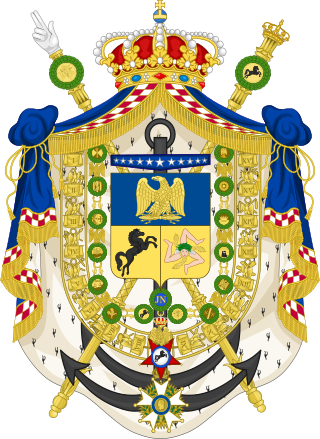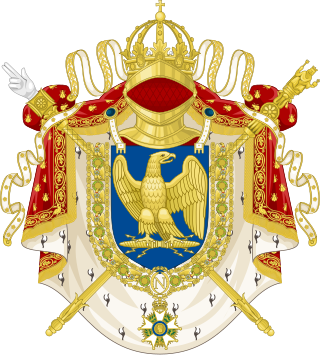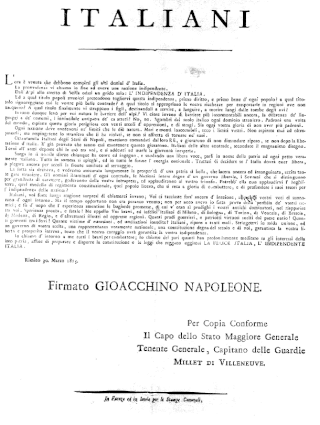
The House of Bonaparte is a former imperial and royal European dynasty of Corsican origin. It was founded in 1804 by Napoleon I, the son of Corsican nobleman Carlo Buonaparte and Letizia Buonaparte. Napoleon was a French military leader who rose to power during the French Revolution and who, in 1804, transformed the First French Republic into the First French Empire, five years after his coup d'état of November 1799. Napoleon and the Grande Armée had to fight against every major European power and dominated continental Europe through a series of military victories during the Napoleonic Wars. He installed members of his family on the thrones of client states, expanding the power of the dynasty.

Charles XIV John was King of Sweden and Norway from 1818 until his death in 1844 and the first monarch of the Bernadotte dynasty. In Norway, he is known as Charles III John and before he became royalty in Sweden, his name was Jean-Baptiste Jules Bernadotte. During the Napoleonic Wars, he participated in several battles as a Marshal of France.

Joseph-Napoléon Bonaparte was a French statesman, lawyer, diplomat and older brother of Napoleon Bonaparte. During the Napoleonic Wars, the latter made him King of Naples (1806–1808), and then King of Spain (1808–1813). After the fall of Napoleon, Joseph styled himself Comte de Survilliers and emigrated to the United States, where he settled near Bordentown, New Jersey, on an estate overlooking the Delaware River not far from Philadelphia.

The House of Bernadotte is the royal family of Sweden, founded there in 1818 by King Charles XIV John of Sweden. It was also the royal family of Norway between 1818 and 1905. Its founder was born in Pau in southern France as Jean Bernadotte. Bernadotte, who had been made a General of Division and Minister of War for his service in the French Army during the French Revolution, and Marshal of the French Empire and Prince of Ponte Corvo under Napoleon, was adopted by the elderly King Charles XIII of Sweden, who had no other heir and whose Holstein-Gottorp branch of the House of Oldenburg thus was soon to be extinct on the Swedish throne. The current king of Sweden, Carl XVI Gustaf, is a direct descendant of Charles XIV John.

Marie Julie Clary, was Queen of Naples, then of Spain and the Indies, as the wife of Joseph Bonaparte, who was King of Naples from January 1806 to June 1808, and later King of Spain and the Spanish West Indies from 25 June 1808 to June 1813.

Joachim Murat was a French military commander and statesman who served during the French Revolutionary Wars and Napoleonic Wars. Under the French Empire he received the military titles of Marshal of the Empire and Admiral of France. He was the first Prince Murat, Grand Duke of Berg from 1806 to 1808, and King of Naples as Joachim-Napoleon from 1808 to 1815.

The Guadeloupe Fund was established by Sweden's Riksdag of the Estates in 1815 for the benefit of Crown Prince and Regent Charles XIV John of Sweden, also known as Jean Baptiste Jules Bernadotte, and his heirs.

The Neapolitan War, also known as the Austro-Neapolitan War, was a conflict between the Napoleonic Kingdom of Naples and the Austrian Empire. It started on 15 March 1815, when King Joachim Murat declared war on Austria, and ended on 20 May 1815, with the signing of the Treaty of Casalanza. The war occurred during the Hundred Days between Napoleon's return from exile and before he left Paris to be decisively defeated at the Battle of Waterloo. The war was triggered by a pro-Napoleon uprising in Naples and ended with a decisive Austrian victory at the Battle of Tolentino, after which Bourbon monarch Ferdinand IV was reinstated as King of Naples and Sicily. However, the intervention by Austria caused resentment in Italy, which further spurred on the drive towards Italian unification.

Carolina Maria Annunziata Bonaparte, better known as Caroline Bonaparte, was an Imperial French princess; the seventh child and third daughter of Carlo Buonaparte and Letizia Ramolino, and a younger sister of Napoleon I of France. She was queen of Naples during the reign of her spouse there, and regent of Naples during his absence four times: in 1812–1813, 1813, 1814, and 1815.

The Grand Duchy of Berg, also known as the Grand Duchy of Berg and Cleves, was a territorial grand duchy established in 1806 by Napoleon after his victory at the Battle of Austerlitz (1805) on territories between the French Empire at the Rhine river and the German Kingdom of Westphalia.

Prince Murat is a French princely title that traces its origin back to 1804, when Emperor Napoleon granted the rank of prince français to his brother-in-law Joachim Murat, who subsequently reigned as King of Naples from 1808 to 1815. On 5 December 1812, Joachim Murat's second son Lucien was created sovereign Prince of Pontecorvo in succession to Jean-Baptiste Jules Bernadotte, by an Imperial Decree.

Lucien Charles Joseph Napoléon, Prince Français, Prince of Naples, 2nd Prince de Pontecorvo, 3rd Prince Murat was a French politician, and the sovereign Prince of Pontecorvo between 1812 and May 1815.

As Emperor of the French, Napoleon I created titles in a newly established noblesse impériale to institute a stable elite in the First French Empire, after the instability resulting from the French Revolution.

Marshal of the Empire was a civil dignity during the First French Empire. It was created by Sénatus-consulte on 18 May 1804 and to a large extent reinstated the formerly abolished title of Marshal of France. According to the Sénatus-consulte, a Marshal was a grand officer of the Empire, entitled to a high-standing position at the court and to the presidency of an electoral college.

The First French Empire, officially the French Republic, then the French Empire after 1809 and also known as Napoleonic France, was the empire ruled by Napoleon Bonaparte, who established French hegemony over much of continental Europe at the beginning of the 19th century. It lasted from 18 May 1804 to 3 May 1814 and again briefly from 20 March 1815 to 7 July 1815, when Napoleon was exiled to St. Helena.

Pontecorvo is a town and comune in the province of Frosinone, Lazio, Italy. Its population is c. 13,200.

The Rimini Proclamation was a proclamation by Joachim Murat, King of Naples, calling for the establishment of a united, self-governing Italy ruled by constitutional law. Its text is widely attributed to Pellegrino Rossi, later Papal Minister of Interior under Pope Pius IX. While it is primarily considered as a desperate attempt from Murat to retain the Neapolitan throne, the Rimini Proclamation was among the earliest calls for Italian unification.
Prince Bernadotte is a title that has been used by several members of the House of Bernadotte. It is most commonly known as a title granted to men who were formerly titled as princes of Sweden before losing their royal titles when they married unequally and against the Swedish constitution. It was created in 1892 as a non-hereditary title in the nobility of Luxembourg and conferred upon Oscar Bernadotte by Adolphe, Grand Duke of Luxembourg. A title with the same name was subsequently created in 1937 as a non-hereditary title in the nobility of Belgium and conferred upon Carl Bernadotte by King Leopold III of Belgium. The wives of these princes of Luxembourgish and Belgian nobility were then granted the title of Princess Bernadotte. The title was also used in the early 19th century with reference to Jean Baptiste Jules Bernadotte, the subsequent founder of the Swedish royal House of Bernadotte.

The Kingdom of Naples was a French client state in southern Italy created in 1806 when the Bourbon Ferdinand IV & III of Naples and Sicily sided with the Third Coalition against Napoleon and was in return ousted from his kingdom by a French invasion. Joseph Bonaparte, elder brother of Napoleon I, was installed in his stead: Joseph conferred the title "Prince of Naples" to be hereditary on his children and grandchildren. When Joseph became King of Spain in 1808, Napoleon appointed his brother-in-law Joachim Murat to take his place. Murat was later deposed by the Congress of Vienna in 1815 after striking at Austria in the Neapolitan War, in which he was decisively defeated at the Battle of Tolentino.






















